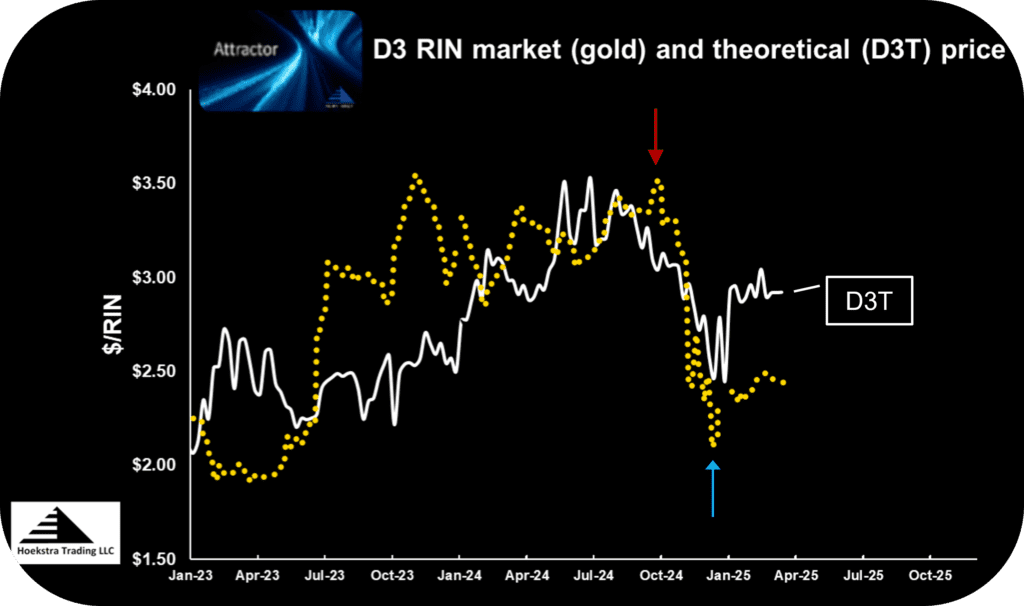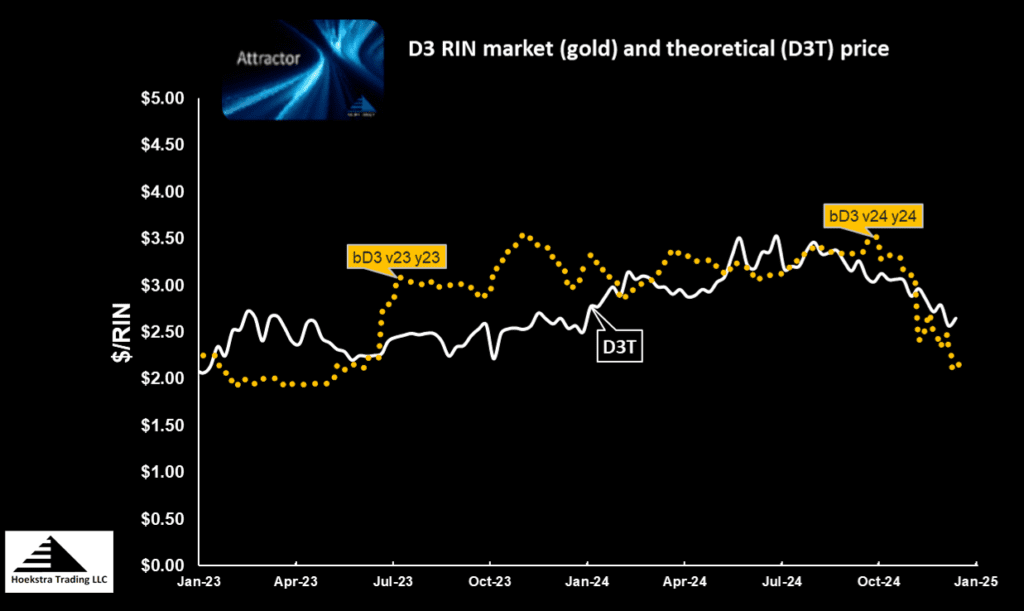Posts by Hoekstra Trading LLC
What’s Next for Cellulosic Biofuel and the D3 RIN? – Part 8, A New Industry Emerges
See previous blogs in this series: Cellulosic biomass consists of non-food crops and waste biomass like corn stalks, corncobs, straw, wood, wood byproducts methane emitted from landfills and animal manure. In 2007, the Renewable Fuels Standard (RFS) set mandates for generating transportation fuels from these raw materials and other categories of biomass. The vision was…
Read MoreWhat’s Next for Cellulosic Biofuels and the D3 RIN Part 6 – D3 RIN Price – Is The Market Off By a Factor of Ten?
See previous posts in this series, What’s Next For Cellulosic Biofuels and the D3 RIN?: Familiar corporate names like Waste Management, Cummins, Freightliner and BP have joined forces with dozens of less familiar public companies and startups to form a new American industry. Thousands of commercial trucks, powered by natural gas fueled engines, are on…
Read MoreLove Letters Part 1 – Big Oil Gets Tough Love From Investor Elliott Management
See other blogs in this series: Love Letters Part 2 -Rewind to Aug 27, 2021 – What’s the Missing Piece in Phillips 66 (PSX) Refining Profit Problem? Elliott Management, a private investment firm owning a $2.5 billion stake in Phillips 66 (PSX) stock, published a critique of PSX’s structure, performance, and management in the form…
Read MoreTop 3 Takeaways – OPIS LCFS and Carbon Markets Workshop San Diego
This week’s OPIS Low Carbon Fuel Standard (LCFS) and Carbon Markets Workshop in San Diego was my first immersion in the capital of low carbon fuels regulation, California. As expected, the program was rich in content, highlighted by professionally-moderated panel discussions with experts on every topic I’d hoped to learn about, and I learned a…
Read MoreD4 RIN Price – What’s the Outlook for 2025?
September and October brought bullish predictions for the D4 Renewable Identification Number (RIN). So far they have not played out. What’s the outlook for 2025? Bullish sentiment was in the air this autumn, when D4 RIN market prices rose into the high 70’s from a February low of 39 cents (much like happened with Chicago…
Read MoreWhat’s Next for Cellulosic Biofuels and the D3 RIN Part 6, Quantitative Theoretical Modeling of RIN prices.
Read previous blogs in this series: Hoekstra Trading’s ATTRACTOR spreadsheet was released in 2020. It uses this diagram of the diesel branch of the Renewable Identification Number (RIN) price control system. NOTE: THE NUMBERS SHOWN IN FIGURE 1 ARE HYPOTHETICAL. If you were a chemical engineer looking at Figure 1, you would instinctively start drawing…
Read MoreWhat’s Next for Cellulosic Biofuel and the D3 RIN? – Part 5, Impact of EPA’s Partial Waiver on the D3 RIN Price
Read other blogs in this series: On December 5th 2024, EPA issued a proposal to partially waive the cellulosic biofuel volume requirement for 2024 from 1.09 billion to 0.88 billion Renewable Identification Numbers (RINs). This requirement sets the minimum volume of annual supply of biofuels made from cellulosic biomass like wood chips, corn stalks, landfill…
Read MoreHoekstra Announces New Bloomberg Licensing Agreement – “D3T” Goes Live Dec. 9, 2024
Hoekstra Trading LLC is pleased to announce a new data licensing agreement with Bloomberg Finance LP that grants Bloomberg the right to use, display, and deliver Hoekstra Trading’s “D3T” value to Bloomberg users starting December 1st 2024. D3T is the theoretical value of a D3 Renewable Identification Number (RIN), an environmental credit that subsidizes supply…
Read MoreWhat’s Next For Cellulosic Biofuels and the D3 RIN Part 4 – Fueling Heavy Duty Trucks With Fuel From Cows
Read other blogs in this series: In 2007, a primary objective of the Renewable Fuel Standard (RFS) was to stimulate development of at least 16 billion gallons/year of liquid fuels made from cellulosic biomass which consists of non-food crops and waste biomass like corn stalks, corncobs, straw, wood, and wood byproducts. But the 2007 vision…
Read MoreWhat’s Next For Cellulosic Biofuels and the D3 RIN? Part 3 – Rewind to the Fast Crash of Kior, a Cellulosic Biofuel Company
Read other posts in this series: What’s next for cellulosic biofuels and the D3 RIN? In 2007, a primary objective of the Renewable Fuel Standard (RFS) was to stimulate development of at least 16 billion gallons/year of liquid fuels made from cellulosic biomass which consists of non-food crops and waste biomass like corn stalks, corncobs,…
Read More








